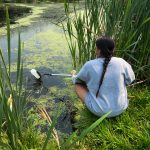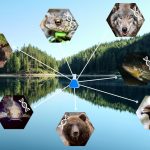PROGRAM GOAL
Nestled in mountainous regions surrounded by glaciers and snow, headwaters mark the starting point of community water supply and the waterways vital for aquatic ecosystems.
Temperatures at higher altitudes are accelerating at a faster rate than at lower altitudes. As a result, high elevation ecosystems are more vulnerable and expected to experience climate impacts more rapidly. Climate impacts on headwaters will have a trickle-down effect on lower elevation water systems that human communities and all other species rely on.
The aim of the High Elevation Monitoring Program is to establish long-term monitoring and generate data that will lead to a better understanding of changes occuring in high elevation ecosystems and what these changes mean for the future of water supply in our study areas. The results will be used to identify climate change driven impacts and quantify their effects on these sensitive areas, and assist in the development of watershed management solutions.
The program supports the Columbia Basin Water Monitoring Framework (CBWMF) by contributing water supply and quality data collected at the headwaters of the watersheds being studied. This data is used in conjunction with the data collected by the CBWMF to track and understand climate impacts on water supply for communities and ecosystems. Data is shared on the Columbia Basin Water Hub and accessible by government, academia, Indigenous and non-Indigenous communities, and the public.
Currently, this program is operating at a reduced capacity, with a more focused approach that reflects current funding. We are continuing climate and snow monitoring at a number of high-elevation sites and remain committed to tracking these sensitive ecosystems. We are exploring opportunities for additional funding that could allow us to fully reinstate and expand the program's monitoring efforts.
We are excited to partner with the Alpine Club of Canada for the citizen science data collection component of this program.
HOW THE PROGRAM WORKS
The aim of this program is to generate data on high elevation ecosystems, and establish long-term monitoring, which may be used to identify changes in mountain headwaters and the downstream communities caused by climate impacts.
Monitoring parameters include biological, physical and chemical components of alpine lakes and streams, as well as vegetation and wildlife observations. The program also hosts a citizen science project on iNaturalist.
Objectives:
- To establish high elevation monitoring locations for ongoing, year-on-year data collection.
- To determine the natural variation and long term trends in selected physical, chemical, and biological water quality parameters on high elevation lakes and streams.
- To foster water stewardship with a broader cross-section of the public, helping them to understand climate change impacts on the health of headwaters and the watersheds in general.
- Monitoring will be performed by certified technicians, recreationalists, alpine enthusiasts and Living Lakes Canada staff.
- The goal is to expand the program geographically to include high elevation regions of various headwaters within British Columbia and Alberta.
Measurements:
- Lake and stream physiology: temperature, transparency, and bathymetry
- Water chemistry: pH, specific conductivity, dissolved oxygen, turbidity, nitrogen, phosphorus, Fluorescent Dissolved Organic Matter (FDOM), Total Algae
- Biological characteristics: algae, zooplankton, macroinvertebrates
Citizen Science:
Join our iNaturalist project: High Elevation Monitoring Program - Living Lakes Canada and help us identify and track species within the following monitoring locations:
How to use iNaturalist
- After creating an iNaturalist account, volunteers can join the Living Lakes Canada - High Elevation Monitoring Projects.
- Simply search High Elevation Monitoring on the app and a list of the projects will appear.
- Volunteers take pictures, via the app, of any flora and fauna spotted while recreating within the project areas. This will create an inventory of plant and animal species. A specific location will be recorded automatically as well as the image.
- When back in cell service, volunteers can upload their photos/observations via iNaturalist. The photos will be automatically added to a project based on geographic location. Scientists and the iNaturalist community will confirm species identifications and the data will be stored on the iNaturalist database.
- Living Lakes Canada extracts this data and uploads it to the Columbia Basin Water Hub to make it easily accessible.
Safety: Coordinates listed on the iNaturalist project pages are to provide project members with an idea of the project location. Please follow designated trails and respect flora and fauna while taking photos.
PROGRAM TIMELINE
View the full timeline (Years 1-4) here.
CONTACT
We encourage anyone interested in understanding the health of high elevation ecosystems in a region of interest to get involved. There are multiple levels of possible participation. To learn more, email us at highelevation@livinglakescanada.ca.

News and Updates
Collecting Data From Alpine Peaks to Valley Streams – Alpine Club of Canada, May 23 2025
Low snowpack expected to further impact water sources as drought conditions continue – The Nelson Daily, Feb 18 2023
Living Lakes Canada: Tracking Climate Impacts on Alpine Freshwater Systems – Alpine Club of Canada’s State of the Mountains Report, Oct 2023
A changing landscape: High elevation fieldwork at Talus Lodge – Backcountry Lodges of B.C., Aug 29 2023
A Changing Landscape: High Elevation Fieldwork at Talus Lodge – Alpine Club of Canada, Aug 16 2023
High Elevation Monitoring in the Columbia Basin: Pilot Year Summary Report – Living Lakes Canada, Apr 2023








